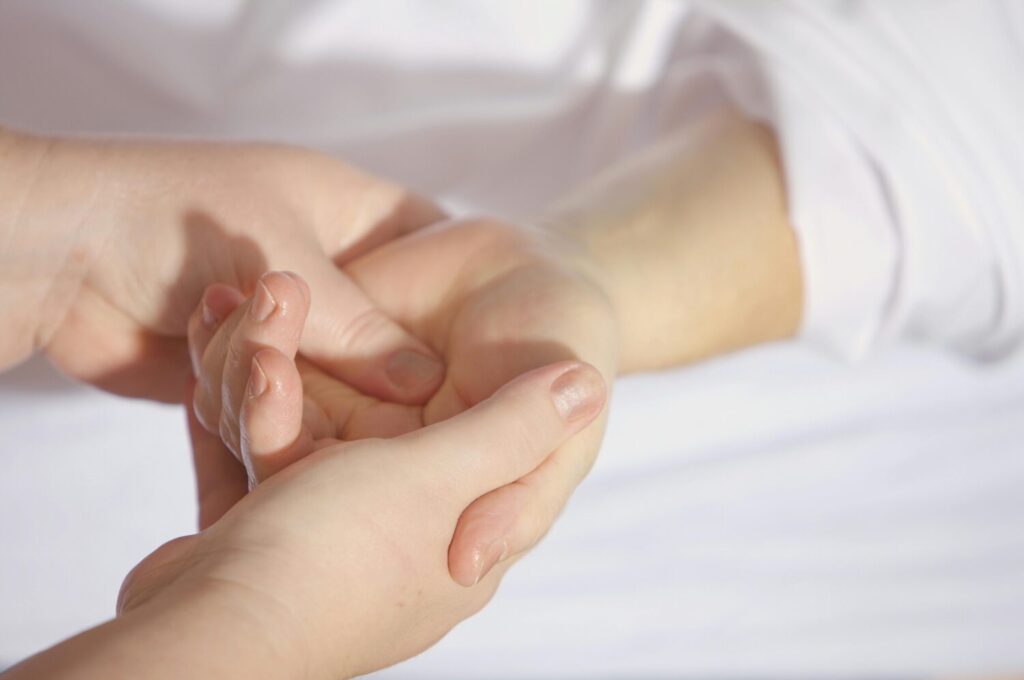Carpal Tunnel Syndrome (CTS) is a common condition that affects millions of people worldwide. It occurs when the median nerve, which runs from the forearm into the palm, becomes compressed within the carpal tunnel, a narrow passage in the wrist. This compression leads to pain, tingling, numbness, and weakness in the hand and fingers.
CTS is typically caused by repetitive hand movements, such as typing, writing, using hand tools, or playing instruments. It can also be linked to underlying medical conditions such as arthritis, diabetes, or hypothyroidism. Many people explore non-surgical treatments to manage CTS symptoms, and massage therapy has gained popularity as a non-invasive treatment. But how effective is carpal tunnel massage in relieving these symptoms? In this blog, we’ll explore benefits, risks, and the best techniques of massage for carpal tunnel.

Can a Massage Help with Carpal Tunnel?
Carpal tunnel massage can be an effective form of manual therapy that can be used on its own or in combination with splinting and exercises to ease symptoms. However, everyone responds to treatment differently and while massage therapy may be extremely beneficial to one person, it may not be the solution for another.
Here is a list of positive side effects to massage therapy for carpal tunnel syndrome:
While Many People Report Relief from Massage Therapy, What do The Statistics Say?
A 2020 study published in the Journal of Clinical Medicine found that manual therapy, including massage, significantly reduced CTS pain and improved wrist function over six weeks. A 2016 study in the Journal of Manipulative and Physiological Therapeutics found that patients who received deep tissue massage experienced a 38% reduction in symptoms compared to those who did not.
However, some experts caution that massage alone may not provide long-term relief and should be combined with splinting, physical therapy, and medical consultation.
Can Carpal Tunnel Get Worse with a Massage?
Carpal tunnel massages seldom result in adverse side effects. In extremely rare cases, massage can cause nerve injuries. A hand massage for carpal tunnel is far less invasive than open or endoscopic surgery and has fewer side effects than taking mediations. It’s important to consult with your primary healthcare provider before performing a self-massage for carpal tunnel. Pressing on the wrong trigger points can worsen your symptoms or injure your nerves.
Best Massage Techniques for Carpal Tunnel Relief
Does massage help with carpal tunnel? The answer is yes, but it requires patience. Regular massage sessions can help relieve symptoms over time.
Below are some of the most effective massage techniques for reducing tension and improving circulation in the wrist and forearm

Carpal Tunnel Exercises
Below you’ll find the steps to doctor approved carpal tunnel exercises that can be used in combination with massages.
Who Should Avoid Massage for Carpal Tunnel?
While massage is generally safe and beneficial, there are certain situations where it may not be appropriate. Individuals with acute inflammation, infections near the wrist or hand, or recent wrist fractures should avoid massage until cleared by a medical professional. Pregnant individuals experiencing CTS may require modified massage techniques. People with conditions like advanced diabetes, blood clotting disorders, or those on blood thinners should also consult their healthcare provider before starting any massage regimen. If you’re unsure whether massage is right for you, always check with your doctor or a licensed therapist first.
What to Expect During a Professional Massage Appointment
During a professional massage session for carpal tunnel syndrome, your therapist will typically focus on the hands, wrists, forearms, and sometimes even the shoulders and neck. Sessions may last between 30 to 60 minutes and can involve a combination of techniques like effleurage, trigger point therapy, and myofascial release. Your massage therapist might use oils or lotions to reduce friction and enhance glide during the treatment. Most clients report feeling relaxed after the session, though some experience temporary soreness, which usually resolves within 24 hours.
Self-Massage vs. Professional Massage
Both self-massage and professional massage can help manage carpal tunnel symptoms, but each has its strengths. Self-massage offers convenience and cost-effectiveness, allowing you to target discomfort whenever it arises. However, professional massage provides deeper muscle work and a more targeted approach, particularly helpful for chronic or complex symptoms. For best results, consider combining both: use self-massage techniques at home between your scheduled professional sessions to maintain progress and relieve daily strain.
At-Home Remedies to Complement Massage
In addition to massage and exercises, several at-home remedies can support your recovery from carpal tunnel syndrome. Wearing a wrist splint, especially at night, can help keep your wrist in a neutral position and reduce pressure on the median nerve. Applying ice packs for 10–15 minutes at a time may relieve inflammation, while warm compresses can relax tight muscles. Ergonomic adjustments to your workspace—like using a supportive keyboard or mouse pad—can prevent further strain. Always ensure your posture supports proper wrist alignment during daily activities.
When to Consult a Doctor
Take a break from the exercises and get massages for carpal tunnel syndrome if you start to feel significant pain or numbness. If the pain persists or your symptoms don’t improve after three to four weeks of performing the carpal tunnel exercises, you should consult with your primary healthcare provider or physical therapist.
Here are signs that you should seek medical help:
Symptoms persist for more than six weeks despite self-care efforts.

Final Thoughts
Massage therapy can be an effective, non-invasive treatment for carpal tunnel syndrome when used correctly. It helps relieve pain, reduce nerve compression, and improve flexibility in the wrist and fingers.
However, massage alone may not be enough, and it’s best used alongside exercises, splinting, and other medical treatments. If symptoms persist, it’s essential to consult a doctor for further evaluation.
If you’re ready to try massage for carpal tunnel, contact our team to book your appointment at Positive Mind Wellness.



